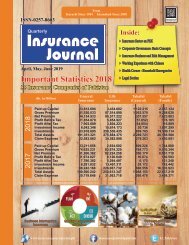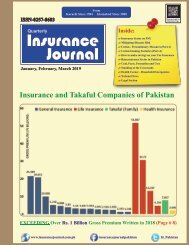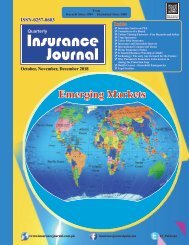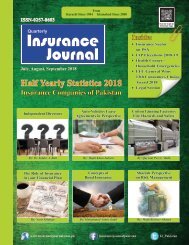Insurance Journal (3rd Quarter 2020)
Create successful ePaper yourself
Turn your PDF publications into a flip-book with our unique Google optimized e-Paper software.
Health Corner
F R E Q U E N T L Y A S K E D
QUESTIONS
What are the symptoms? How can
you tell the difference between the
coronavirus and a cold or flu?
The symptoms are similar including
fever, cough, and shortness of breath.
To diagnose a potential case, your
doctor may use a COVID-19 PCR test
to rule out flu and other infections.
Individuals with COVID-19 have had
a wide range of symptoms, ranging
from mild to severe illness. Some
individuals who are infected may not
have symptoms, others require
ventilator support, and many have
died. Symptoms may appear two to 14
days after exposure to the virus and
may include:
Ÿ
Ÿ
Ÿ
Ÿ
Ÿ
Ÿ
Ÿ
Ÿ
Ÿ
Ÿ
Ÿ
Ÿ
Fever
Cough
Shortness of breath or difficulty
breathing
Chills
Fatigue
Muscle pain or body aches
Headache
Sore throat
New loss of taste or smell
Congestion or runny nose
Nausea or vomiting
Diarrhea
This list does not include all possible
symptoms. If you develop any
symptoms and think you have been
exposed, call a doctor immediately.
W h a t a re t h e s y m p t o m s i n
children?
Children with COVID-19 may have
mild, cold-like symptoms such as
fever, runny nose, cough and some
children experience vomiting and
diarrhea. Rarely, a child gets really
sick after being infected with
COVID-19. National Institute of
Health advises parents to call a
pediatrician if their child has any of
the following symptoms:
Ÿ
Ÿ
A fever that will not go away
Abdominal pain, diarrhea, or
Ÿ
Ÿ
Ÿ
vomiting
Rash or changes in skin color pink
or red eyes
Trouble breathing
The child seems confused or
overly sleepy
Are individuals transmissible
before they develop symptoms?
There is evidence that the COVID-19
can be spread before an individual
develops symptoms. This creates a
problem because people who do not
know they are infected may continue
to go to work, school and other public
places. People who are sick and have
symptoms are more likely to stay
home which means fewer chances for
the virus to spread from one person to
another. When asymptomatic
transmission occurs, infection control
experts and public health officials
may need to take additional measures,
such as social distancing, smart
lockdowns, isolating patients or using
quarantines.
What should individuals do if they
think they may have been infected?
Those who think they may have been
exposed to coronavirus, either
through travel to an affected area or
close contact with someone who has a
confirmed case, should call a doctor
or helpline 1166 if they have any of
the symptoms. It is important to call
first, so that the clinic or hospital can
prepare and prevent the spread of
infection. Stay home and away from
other people if you might have been
exposed to COVID-19.
Who is at greatest risk of serious
illness due to COVID-19?
Although, anyone can affect but
individuals at greater risk of severe
illness from COVID-19 include the
following:
Ÿ
People with chronic medical
conditions like kidney disease,
sickle cell disease, heart disease,
type 2 diabetes and lung disease,
including chronic obstructive
Ÿ
Ÿ
Ÿ
Ÿ
pulmonary disease (COPD)
Older adults (the older people are
the higher their risk for severe
illness)
Obese people
Those who have a weakened
immune system from organ
transplant
Others who may be at risk of more
severe illness include people who
have asthma, high blood pressure,
neurologic conditions such as
dementia, cerebrovascular disease
such as stroke, people who are
pregnant or those who are
immunocompromised due to
cancer treatment and other
conditions.
How does COVID-19 affect
pregnant women?
According to available data, pregnant
women with COVID-19 may be more
likely to experience pre-term birth
and are more likely to experience
severe illness from COVID-19 than
non-pregnant women. Pregnant
women should be aware about
reducing their risk of getting sick and
ensuring that those around them also
take steps to minimize risk including
proper hand washing, social
distancing and wearing a face mask in
public.
How is the COVID-19 transmitted?
The virus that causes COVID-19 is
supposed to spread mainly through
close contact from person-to-person
(within about 6 feet). It can be spread
through respiratory droplets when an
infected person coughs, sneezes or
talks. Recent studies have indicated
that COVID-19 may be spread by
people who are not showing
symptoms which is why face masks
are recommended.
What can individuals do to protect
themselves?
Everyone should practice the
following healthy habits to help
prevent the spread of COVID-19 and
other respiratory viruses:
Insurance Journal July, August, September 2020
30
Find us at: www.insurancejournal.com.pk — www.facebook.com/insurancejournalpakistan

















